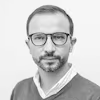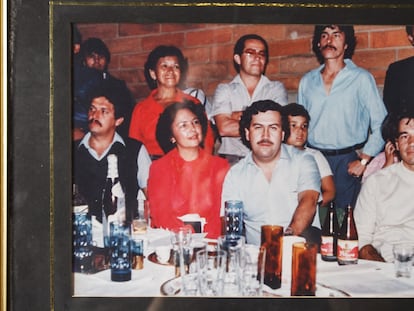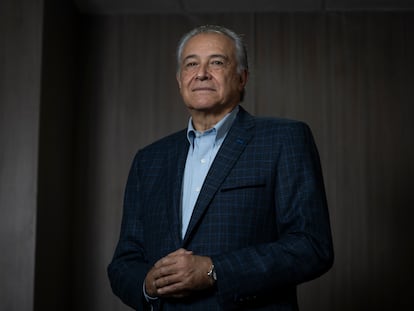Carlos Lehder revives the ghosts of Pablo Escobar and the era of the drug lords
In an upcoming book, the released German-Colombian former drug lord addresses dirty money in political campaigns, the pacts made between the Medellín Cartel and the guerrillas, as well as the complicity of the governments of Nicaragua, Cuba and Panama in the drug trade

Carlos Lehder, 74, was one of the founders of the Medellín Cartel. He became famous for all kinds of excesses, building an image as a womanizer, a drunk, a lunatic and a fascist. In his bizarre criminal career, he even founded a political party: the National Latin Civic Movement, an anti-communist platform. Above all, he frantically fought the extradition treaty that was negotiated and signed between the governments of Colombia and the United States in the 1980s. During this period of time, he stated that he considered drug-trafficking to be “a revolutionary weapon against imperialism” or “the atomic bomb” of Latin America.
Lehder was captured on February 4, 1987, on a farm near Medellín. After being extradited to the U.S., he was initially sentenced to life imprisonment, plus 135 years. However, he achieved a substantial reduction in his sentence by becoming a protected witness in the case against Panamanian dictator Manuel Antonio Noriega. After spending 33 years in prison in the United States, he was freed in 2020. Today, he lives in Frankfurt, Germany, his father’s country of origin.
Pablo Escobar’s former business partner — who claims that it was Pablo who gave him up to the authorities — has broken the discretion that long marked his life. His book Life and Death of the Medellín Cartel is set to be published in February by Penguin Random House. In the pages of his memoir, he addresses the financing of political campaigns with drug money, the relationship between the traffickers and the guerrillas of the day, as well as the diplomacy that led cartel members to interact with the governments of the Bahamas, Nicaragua, Cuba, and Panama, as they moved cocaine through the Caribbean. Those were the years in which drug-trafficking permeated Colombian society — a prelude to the war, in which Escobar said he preferred a grave in Colombia to a prison in the United States.
“I was a gangster,” Lehder conceded this week, in an unusual interview with W Radio, a Colombian station. “The decisions I made continue to be an enigma,” he replied to journalist Julio Sánchez Cristo. “After surviving all those hardships, I decided, [as a free man], to write my biography, my book, my story, my experiences. To share them with my compatriots, so that they won’t be tempted in the future — and in the present — to go for the easy money of drug-trafficking.”
“People should avoid getting infected,” he continued, “because the justice systems are already so advanced that anyone who gets involved ends up in jail. You’ll lose your family and your fortune, or you’ll get killed by the same mafias.” He also spoke of having brought 50 tons of cocaine into the United States during his time with the cartel.
Colombia’s 1982 presidential campaign
Lehder gives his version of how drug money permeated Colombian politics. Among others, he mentions former presidents Alfonso López Michelsen (1974-1978) and Belisario Betancur (1982-1986), both deceased. He assures readers that, in the 1982 presidential campaign, López — who had already been president and was running for the Liberal Party — received contributions from Pablo Escobar and seven other drug traffickers, who gave the candidate $100,000 (about $350,000 in today’s money) and met with him. According to Lehder, these alleged contributions were part of the strategy to prevent the feared extradition treaty from being signed.
At the time, Lehder himself revealed these alleged contributions to the press, on Escobar’s instructions (when they still presented themselves as “legitimate businessmen”). During his lifetime, López always denied his links to the Medellín Cartel, which he reiterated in the trial against Noriega. In a book of interviews, the former president noted that the controversial meeting that he had with the drug lords was insignificant. “I was in a hurry. I came in for a moment and didn’t even sit down. I shook hands with some guys I didn’t know,” he told journalist Enrique Santos.
Lehder also writes that drug lord Gonzalo Rodríguez Gacha, alias El Mexicano, didn’t want to contribute, because he considered himself to be conservative. Instead, with some other traffickers, he gave nearly a million dollars to Betancur’s Conservative Party, the eventual winner of the 1982 elections. The third contender in that campaign was Luis Carlos Galán, from the New Liberalism movement. Lehder corroborates that Escobar — bitten by the political bug — tried to get further involved in politics. However, Galán — murdered by order of Escobar in 1989 ― “decided to expel [Escobar from his party], in response to rumors about what Pablo really did for a living.”
The murder of Rodrigo Lara Bonilla
In his memoirs, Lehder refers to the case of Justice Minister Rodrigo Lara Bonilla, who led an effort against drug-trafficking mafias before being murdered in Bogotá. “Pablo Escobar was already allergic to Lara Bonilla’s name being pronounced in his presence. He was [boiling] with rage,” he recalls. Still, Lehder points out that he never knew that Escobar had plans to murder the politician. He describes his first reaction when he found out about the crime on April 20, 1984, after a long day of flying cargo, as “perplexed. I managed to say: ‘What a bummer, that’s not going to help us.’”
“Years later, at the Noriega trial, I confessed that I had also congratulated Pablo,” he admits. “But, unlike Escobar, I didn’t take the path of declaring war on the state and society. Rather, I preferred to hide in the jungle when I saw the persecution that the crime unleashed. Today, I think that Pablo didn’t know how to read the situation; he should have put out a statement in which he explained what had led him to it. By not doing so, he left the rest of us up in the air. I’m sure that he didn’t realize everything that this crime was going to bring down on him and his associates.”
The meeting with Tirofijo (“sure shot”)
Lehder recounts a meeting with Manuel Marulanda Vélez, alias Tirofijo, and Jacobo Arenas, then top leaders of the FARC guerrilla movement. With them, he says that he sealed an agreement regarding drug-trafficking. “They received me cordially, and I — hesitating at first — finally managed to concentrate on what brought me there. I told them that the meeting would be brief and that I was only coming to propose a financial negotiation.”
He concluded his proposal in ten minutes. The FARC leaders agreed to meet again the next day, to inform him of the decision they had made. “Marulanda accepted me in his domain of Vichada (a rural eastern region of Colombia). From then on, I had to be in regular contact with the commander of the 16th front. On the lands I obtained from them, I could build landing strips and operate them,” he notes in the book. “With regards to drug-trafficking, I had to pay the FARC — in cash — 10% of all my profits made in Vichada, the same percentage that all coca plant growers and laboratory owners paid. I accepted the terms as being fair and beneficial to all of us.”
The relationship with the M-19 guerrillas and the takeover of the Palace of Justice
Lehder assures readers that the Medellín Cartel didn’t finance the takeover of the Palace of Justice in Bogotá. The operation — held on November 6, 1985 — was led by the M-19 guerrilla movement. In his youth, President Gustavo Petro was active in this group, although he didn’t participate in the attack. “What I can assure [everyone] about the numerous speculations that involve Pablo Escobar — and, obviously, the Medellín Cartel — in the financing of the takeover is that they’re false versions. Neither Pablo Escobar nor I ever knew beforehand about the M-19′s plans to storm the Palace of Justice. What’s more — in my opinion — this type of guerrilla operation, of assaulting and seizing [the institution], didn’t require great monetary costs, because armed guerrillas don’t receive a salary, nor are they mercenaries under contract.”
These comments resulted in a heated exchange on social media between President Petro and journalist Vicky Dávila, the director of Semana magazine. “It’s now clear that you, Mrs. Vicky, interviewed the surviving head of the Pablo Escobar cartel — Mr. Carlos Lehder — and he told you that they had nothing to do with the takeover of the courthouse… a lie that people like you have repeated thousands of times,” the president scolded her on X (formerly Twitter), his favorite method of communicating.
Dávila — who has been very belligerent towards the government — replied that she didn’t interview Lehder. She claims that she has only repeated the version about the financing that has come from a commission made up of Supreme Court judges.
The Medellín Cartel gains a foothold in the Caribbean
After becoming a pilot, Lehder settled in the Bahamas and bought an island called Norman’s Cay. He then began exporting large volumes of cocaine from the Caribbean. There, he established his operations center for several years. However, then-president Ronald Reagan’s War on Drugs pushed him to seek other routes.
While the issue of extradition was progressing in Colombia, Pablo Escobar came to an agreement with Noriega to transfer his operations to Panama. “[Noriega] was known as Carepiña (’Pineapple face’) due to the marks that a severe bout of acne in his youth left on his face,” Lehder writes. “[The cartel] would refer [to Noriega] as El Tigre (’The tiger’), while Panama would henceforth be known as ‘Palmira.’”
The cartel was installed in the Isthmus with the protection and assistance of the Panama Defense Forces. “Panama as a free port, with the dollar as the national currency, made the entire operation easier for us. Its potential was enormous.” In his statements before the Miami court that tried Noriega for drug trafficking, Lehder assured the judge that the former strongman of Panama met personally with the bosses of the Medellín Cartel in 1982 and 1983, to discuss the terms of their cooperation.
Without complete certainty about how things would turn out in Panama, it was necessary to explore the possibility of turning to Fidel Castro’s regime. After a couple of visits, Lehder writes that he obtained the complicity of Cuba. While he managed to open that route, Lehder had suspicions about the regime and didn’t set foot on the island again. Instead, after spending some time hiding in the Eastern Plains of Colombia, he later accepted the refuge offered by Daniel Ortega in Nicaragua, while other capos opted for Panama. “The Sandinista regime was willing to allow the cartel to use government airstrips to transport South American cocaine to Mexico, in exchange for several million dollars in cash,” he notes. Escobar also briefly ended up there, upon discovering that Noriega planned to hand him over to the Americans.
Delivered by Pablo Escobar
At the end of the book — when he recounts details of his trial in the United States — Lehder confirms that it was his business partner who reported his location, without dwelling on the reasons for that betrayal. “Among the hundreds of papers that the Attorney General’s Office was delivering to my lawyers before the start of my trial, one document was [included] by mistake. In this way, my lawyer learned of secret official information. Even though several lines of the text were crossed out with black marker in the document, it was possible to see that Pablo Escobar was the person who had handed Carlos Lehder over to the Medellín Police.”
Sign up for our weekly newsletter to get more English-language news coverage from EL PAÍS USA Edition
Tu suscripción se está usando en otro dispositivo
¿Quieres añadir otro usuario a tu suscripción?
Si continúas leyendo en este dispositivo, no se podrá leer en el otro.
FlechaTu suscripción se está usando en otro dispositivo y solo puedes acceder a EL PAÍS desde un dispositivo a la vez.
Si quieres compartir tu cuenta, cambia tu suscripción a la modalidad Premium, así podrás añadir otro usuario. Cada uno accederá con su propia cuenta de email, lo que os permitirá personalizar vuestra experiencia en EL PAÍS.
¿Tienes una suscripción de empresa? Accede aquí para contratar más cuentas.
En el caso de no saber quién está usando tu cuenta, te recomendamos cambiar tu contraseña aquí.
Si decides continuar compartiendo tu cuenta, este mensaje se mostrará en tu dispositivo y en el de la otra persona que está usando tu cuenta de forma indefinida, afectando a tu experiencia de lectura. Puedes consultar aquí los términos y condiciones de la suscripción digital.
More information
Archived In
Últimas noticias
Most viewed
- Sinaloa Cartel war is taking its toll on Los Chapitos
- Reinhard Genzel, Nobel laureate in physics: ‘One-minute videos will never give you the truth’
- Oona Chaplin: ‘I told James Cameron that I was living in a treehouse and starting a permaculture project with a friend’
- Why the price of coffee has skyrocketed: from Brazilian plantations to specialty coffee houses
- David King, chemist: ‘There are scientists studying how to cool the planet; nobody should stop these experiments from happening’










































